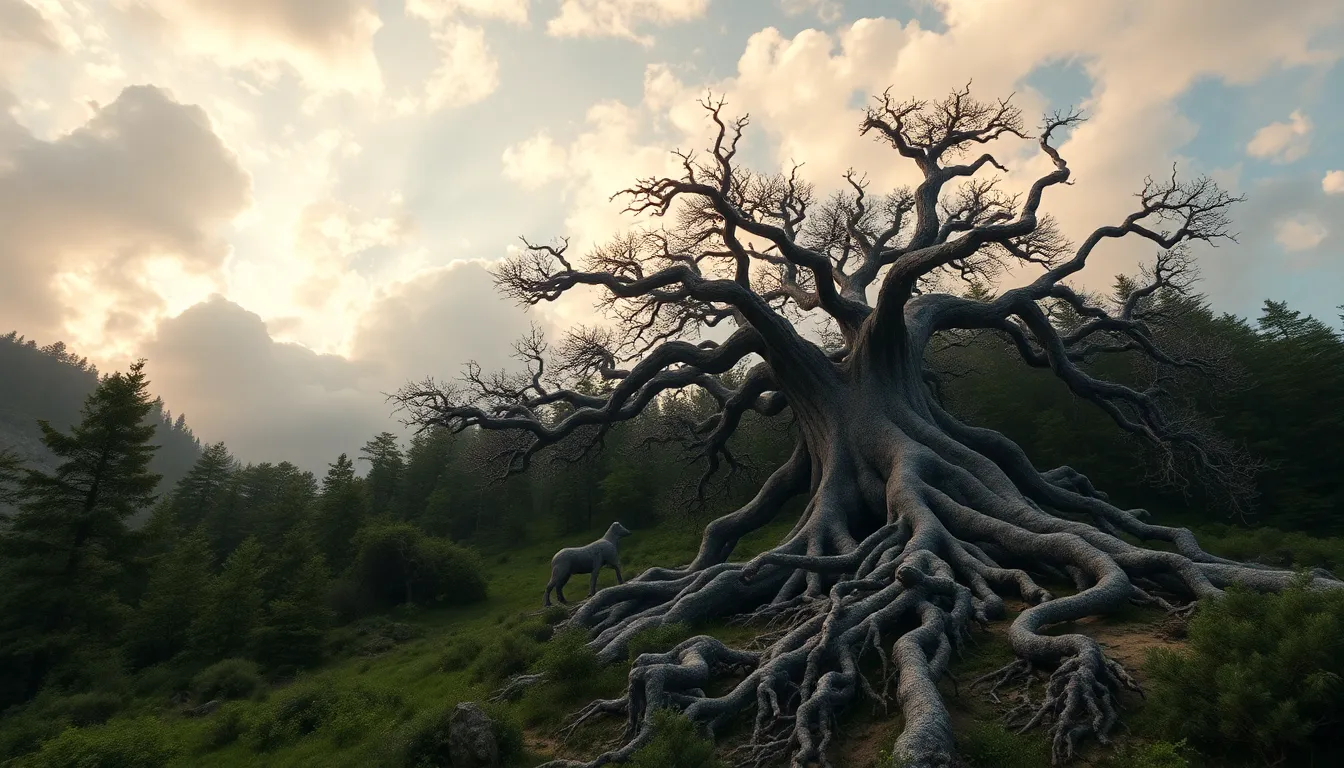From Roots to Sky: The Mythical Journey of the Sacred Cedar
I. Introduction: The Sacred Cedar in Cultural Context
The cedar tree has long been revered across various cultures, often symbolizing strength, longevity, and spiritual connection. Its towering presence and fragrant wood have made it a subject of fascination and respect in countless traditions. The purpose of this article is to explore the journey of the sacred cedar, delving into its historical significance, ecological importance, physical characteristics, artistic representations, and cultural myths.
II. The Historical Significance of Cedar Trees
Throughout history, cedar trees have held a special place in the hearts of many civilizations. From ancient Mesopotamia to the Native American tribes of North America, the cedar has been a symbol of life, death, and rebirth.
- Ancient Civilizations: In ancient Egypt, cedar was used in the construction of temples and tombs, symbolizing immortality. The Phoenicians utilized cedar wood for shipbuilding, recognizing its durability and resistance to decay.
- Religious Texts: The cedar is frequently mentioned in religious texts, including the Bible, where it is used metaphorically to represent strength and safety.
- Traditional Practices: Many cultures have incorporated cedar into their rituals, using it in ceremonies for purification and healing.
III. The Ecological Importance of Cedar Forests
Cedar forests play a critical role in maintaining biodiversity and fostering environmental health. These ecosystems provide habitat for numerous species and contribute to the overall balance of nature.
- Biodiversity: Cedar ecosystems support a variety of plant and animal species, including birds, mammals, and insects that depend on cedar for food and shelter.
- Sustainable Forestry: Cedar trees are integral to sustainable forestry practices, providing valuable resources while maintaining ecological balance.
- Threats and Conservation: Despite their importance, cedar forests face threats from deforestation, climate change, and invasive species. Conservation efforts are essential to protect these vital ecosystems.
IV. The Cedar’s Physical Characteristics and Growth Process
Cedar trees are notable for their distinctive physical characteristics and growth patterns. Understanding these traits can enhance our appreciation for their resilience and adaptability.
- Description of Species: There are several species of cedar, including the Western Red Cedar and the Atlas Cedar, each thriving in unique habitats ranging from moist coastal regions to mountainous areas.
- Growth Stages: Cedar trees undergo several growth stages, starting from seed germination to sapling development, eventually reaching maturity. This process can take several decades, with mature trees often living for hundreds of years.
- Unique Adaptations: Cedar trees have developed adaptations such as drought resistance and pest deterrence, allowing them to thrive in various environments.
V. The Cedar in Art and Literature
The cedar tree has inspired countless artists and writers throughout history, serving as a powerful symbol in both ancient and modern literature.
- Literary Representations: Cedar trees frequently appear in poetry and prose, often symbolizing wisdom, strength, and endurance.
- Art and Crafts: Artists have utilized cedar wood in various forms of art and craftsmanship, creating intricate carvings, furniture, and architectural features.
- Muse for Artists: The majesty of the cedar tree continues to inspire contemporary artists and poets, reflecting its timeless allure.
VI. Myths and Legends Surrounding the Cedar
Myths and legends surrounding cedar trees reveal their deep-rooted significance in various cultures, often depicting them as sacred entities bridging the earthly and spiritual realms.
- Prominent Myths: Many indigenous cultures have myths that highlight the cedar’s protective qualities, believing it to be a gift from the gods.
- Symbolic Meanings: In different cultures, cedar trees symbolize life, prosperity, and protection from evil spirits.
- Spiritual Bridge: The cedar is often viewed as a conduit between the physical and spiritual worlds, used in ceremonies to connect with ancestors and the divine.
VII. The Role of Cedar in Indigenous Cultures
In many indigenous cultures, particularly among Native American tribes, cedar holds profound significance, serving multiple purposes in daily life and spiritual practices.
- Specific Uses: Cedar is used in traditional medicine, ceremonial items, and everyday tools, showcasing its versatility.
- Spiritual Practices: Cedar is often burned in rituals for purification and protection, believed to ward off negative energies.
- Impact of Colonization: The arrival of colonizers disrupted the traditional practices surrounding cedar, leading to loss of knowledge and access to these sacred trees.
VIII. Modern Interpretations and Uses of Cedar
In contemporary society, cedar continues to be valued for its numerous applications, from wellness to sustainable construction.
- Wellness Practices: Cedar essential oils are used in aromatherapy for their calming and grounding properties.
- Sustainable Construction: Cedar wood is favored in eco-friendly building projects due to its durability and resistance to decay.
- Commercial Value: The commercial market for cedar products, including furniture, shingles, and crafts, remains robust, highlighting its economic importance.
IX. The Future of Cedar: Challenges and Opportunities
As we look to the future, cedar trees face significant challenges, but there are also opportunities for preservation and sustainable use.
- Climate Change Impact: Changing climate conditions pose risks to cedar growth, affecting their health and distribution.
- Conservation Strategies: Implementing conservation strategies, such as reforestation and habitat protection, is crucial for preserving sacred cedar species.
- Community Role: Local communities play a vital role in maintaining cedar heritage through education, stewardship, and sustainable practices.
X. Conclusion: The Lasting Legacy of the Sacred Cedar
The cedar tree’s journey from ancient reverence to modern significance illustrates its enduring legacy. As we continue to honor its cultural, ecological, and spiritual importance, it is essential to advocate for its protection and sustainable use, ensuring that future generations can experience the beauty and wisdom embodied in the sacred cedar.




